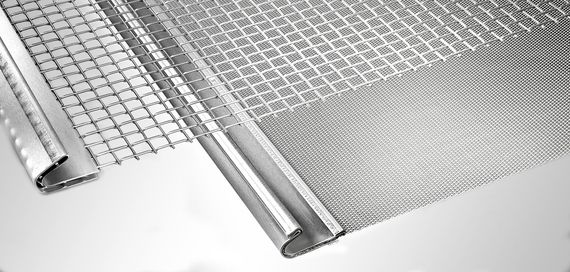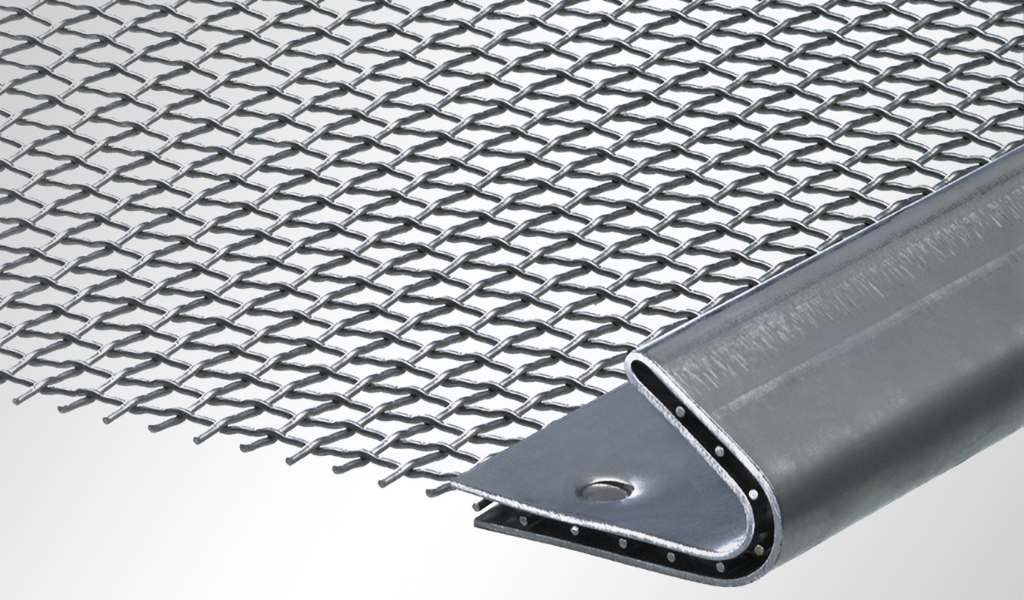Flex-Mat vs Fine Wire Cloth Screen Sections: Which Should I Buy?
Working in the aggregate industry, you will run into materials that vary in profile. From larger granite particles to finer sand particles, the industry dictates the quality and safety of the roads, sidewalks, and buildings we frequent.
For this reason, it is critical that you have the proper tools to screen your material.
Now, screening media come in various configurations and specifications to ensure you can best address the demands of your process. This can be seen when looking at flex mat and fine wire cloth, as both provide their own desirable qualities to the world of aggregate screening.
This probably leaves you curious as to how the two screening media compare.
W.S. Tyler has been in the wire weaving industry for over 150 years, helping project managers build confidence in their ability to screen and process fine aggregate particles. We wrote the following article to help you make heads or tails on whether you should invest in a screen media that resembles flex-mat or fine wire cloth.
With that, you will learn:
- What Flex-Mat is
- What weave types make up the Flex-Mat product line
- What a fine wire cloth vibrating screen is
- What weave types are classified as fine wire cloth
- What screening media you should use
What Is a Flex-Mat Vibrating Wire Screen?
Flex-Mat Vibrating Screen Sections are vibratory screen sections that bond a series of wires, either straightened or crimped, to form exact openings using lime-green polyurethane strips. This construction allows the wire to vibrate freely, allowing for a more efficient material stratification.
Available in both side-tensioned and end-tensioned configurations, Flex-Mat wire screens are designed to greatly reduce the level of blinding, plugging, and clogging that can damage the screen and affect production.
Flex-Mat Weave Types
Currently, there are two major Flex-Mat categories: tensioned screens and modular panels. Both categories are comprised of a handful of different weave types designed with a specific application in mind.
Flex-Mat tensioned screens are designed to allow the individual wire to move independently from the hook mechanism. These weave types have the ability to facilitate faster particle separation and screening.
The following weave types are considered Flex-Mat tensioned screens:
- Tensioned Series D - The standard square Flex-Mat weave pattern that is comparable to a square plain weave wire cloth screen. This particular weave type can be customized to accommodate particles ranging from .059" to 4" (1.5 mm to 101.6 mm).
- Tensioned Series DD - Square weave pattern that has a double wire profile that excels when subjected to high-impact or abrasive materials, making the popcorn effect a thing of the past. This weave type can be fabricated to separate material ranging from 1.125" to 4" (28.6 mm to 101.6 mm)
- Tensioned Series S - Meandering weave pattern designed for use when working with round or cubed material or when precision is not a concern. This particular weave pattern delivers a heightened percentage of open area and dramatically reduces blinding.
Tensioned Series S is perfect for use when particles range from .059" to 2" (1.5 mm to 50.8 mm).
- Tensioned Series T - Modiefeid square weave that places several straight wires in the horizontal direction, splitting the square openings. This design concept allows this particular weave pattern to replace fine mesh patterns that are prone to blinding and plugging.
- Tensioned Series is designed to be used with particles ranging from .020" to 2" (.5 mm to 50.8 mm).
- Tensioned Series L - Weave pattern, consisting of straight wires running in the horizontal, that is designed to provide an optimal open area in efforts to remove finer particles. It's particularly beneficial when used to separate the particles of topsoils and composts.
This weave pattern is ideal for particles ranging from .031" (.8 mm) and up.
Flex-Mat modular panels are vibrating wire screen variants that are designed to facilitate seamless replacement. These panels deliver an enhanced level of screening surface area.
The following weave types are considered Flex-Mat modular panels:
- Modular Series D The Flex-Mat weave pattern is made up of precise square openings that are comparable to a square plain weave wire cloth screen. Unlike the tension series, D screens are made for particles ranging from 0.059" to 1.575" (1.5 mm to 40 mm).
- Modular Series S - Meandering weave pattern that delivers optimal screening when working with particles that are cubed or spherical. This particular weave pattern delivers a heightened percentage of open area and dramatically reduces blinding.
Modular Series S is perfect for use when particles range from 0.059" to 1.575" (1.5 mm to 40 mm).
- Modular Series T - Modiefeid square weave that places several straight wires in the horizontal direction, splitting the square openings. This design concept allows this particular weave pattern to replace fine mesh patterns that are prone to blinding and plugging.
Tensioned Series is designed to be used with particles ranging from 0.020" to 0.055" (0.5 mm to 1.397 mm).
What Is a Fine Wire Cloth Screen Section?

Wire cloth screen sections, widely referred to as aggregate screen cloth, are sections of woven wire mesh designed to separate particles ranging from 4 mesh down to 325 mesh. Typically, these screen sections are placed into vibrating screen machines and comprised of one or two layers of mesh.
These vibrating screen machines generally contain one or multiple screening decks to facilitate the particle separation process. To ensure a secure operation, wire cloth screen sections feature a clamping hook that keeps the screen in place while also allowing the screen to be swapped out with ease.
Fine Wire Cloth Weave Types
W.S. Tyler offers three fine wire cloth variants: square mesh, Ty-Rod, and TON-CAP. While these weave types are all designed to accurately screen fine particles, their distinguished weave patterns can make one more beneficial than the other, depending on the situation.
- Square mesh is the standard fine wire weave type and features a basic over-under profile. Its ability to accurately hold its configuration makes it applicable to a wide range of fine aggregate operations.
- Ty-Rod is a slotted weave that can be woven to have openings up to two inches long. The slotted openings not only work to increase material flow, but they prevent blinding that can lead to wasted time taken to unclog the mesh.
- TON-CAP is short for tonnage capacity and is comprised of wires that have a relatively thicker diameter. The thicker wires used to weave this pattern helps preserve the accuracy and longevity of the pore openings when subjected to heavy loads while also improving throughput.
Which One Should I Buy?
The performance of both Flex-Mat and fine wire cloth screen sections go hand in hand, as both are designed to screen aggregate. That said, determining which one makes more sense for you comes down to the size of your material.
Flex-Mat is fabricated with much larger pore openings, allowing them to screen larger particles seen in mining quarries. Fine mesh is fabricated with much smaller openings that can test fine particles such as sand.
So, if you are working with high-impact aggregates ranging from .02" (.5mm) to 4" (101.6mm), then Flex-Mat will best suit your needs. But if you are working with finer particles ranging from 4 mesh (.187") to 325 mesh (.0017), then you should use fine wire cloth.
Ensure Fine Wire Cloth Vibrating Screens Fit Your Budget
Flex-Mat and fine wire cloth vibrating screens are both screening media used to screen various aggregates. Flex-mat is designed to screen the larger aggregate particles, whereas fine wire cloth vibrating screens are designed to screen finer particles.
Now, if after reading this you feel fine wire cloth screens best suit your needs, you must ensure that they can accommodate your budget. There are many specifications that control the overall price that you can leverage to ensure you can implement a solution this performs and is cost-effective.
Having been prominent leaders in the wire mesh industry for over 150 years, W.S. Tyler is here to support you along your journey towards accurate fine particle screening.
Read the following article to learn more about the different factors that go into the cost of a fine cloth vibrating screen:
About Ronnie Brown
Ronnie is the Content Writer for W.S. Tyler and has four years of experience as a professional writer. He strives to expand his knowledge on all things particle analysis and woven wire mesh to leverage his exceptional writing and graphic design skills, creating a one-of-a-kind experience for customers.



